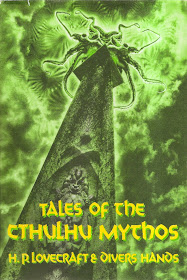Like "Sticks" by Karl Edward Wagner, Robert Bloch's "Notebook Found in an Deserted House" is a story of the Cthulhu Mythos. I don't see much connection between Bloch's story and The Blair Witch Project, but there are similarities to stories by H.P. Lovecraft. That shouldn't come as any surprise, as Bloch was a member of Lovecraft's circle. In Bloch's story, there are deep wells as in "Pickman's Model," an altar or sacrificial slab of stone as in "The Dunwich Horror," and of course the menace of unknown creatures pressing in from the outside. (1) Some of those creatures are Shoggoths, and they are described in Bloch's story in horrifying verisimilitude.
* * *
I came to "Notebook Found in a Deserted House" by way of The Blair Witch Project. As I wrote yesterday, both are "found footage" stories. Bloch's story takes the form of a notebook, as the title explains outright, so it isn't really "footage." (2) A more inclusive term might be a "found artifact" story. (3) That brings me to a more interesting connection among "Notebook Found in a Deserted House," The Blair Witch Project, and the work of H.P. Lovecraft.
The "found artifact" story is old. The "found footage" story is new. What's new about it? The technology used to record the story. And when did that new technology come about? In the nineteenth century of course, in still photography (1820s), sound recording (1870s), the telephone (1876), motion picture photography (1890s), and radio (1890s). Here were true innovations. It could only have been a matter of time before they made their way into nascent science fiction. So what were the first "found artifact" stories involving those five technological developments? I don't know. That would make an interesting research project. (4) But in writing about The Blair Witch Project and "Notebook Found in a Deserted House," I thought of "The Statement of Randolph Carter" by H.P. Lovecraft (1920). Lovecraft's story is documentary, a transcript of a statement made by the title character, presumably to the police, perhaps even as a voice recording. (5) But the story turns on a piece of technology, a portable telephone used by the investigators in their exploration of a tomb. Without that piece of technology, the story could not have been told, and in that, I can see a connection, however tenuous, to The Blair Witch Project, made eight decades later. (6)
Notes
(1) Cap, the mailman, reminds me of the grandfather in The Lost Boys, who knows what's going on.
(2) "Notebook Found in a Deserted House" is a great title, guaranteed to pull in the curious reader. The title also serves as a framing device in the most economical way. I can think of one other title with multiple functions. There Will Be Blood is, at one and the same time: 1) A title; 2) A synopsis of the story; and 3) A movie review.
(3) A story told in the form of letters back and forth between correspondents is called an epistolary story. What is a story told in the form of a notebook called? A notatory story?
(4) Orson Welles' radio play "The War of the Worlds" from 1938 is a kind of "found artifact" story except there is no artifact: the story is broadcast live as it is happening. And it wasn't found, unless you found it on your dial. Maybe a more inclusive term is needed. The "documentary" story? That doesn't quite work, for a story can be documentary but not include any found artifact. The found aspect adds an irreplaceable dimension of mystery to a story. So found artifacts can be used in building a documentary story, as in "The Call of Cthulhu," thus making the story more mysterious and suspenseful.
(5) Note the similarity of the title--as a kind of framing device or setup--to that of Bloch's story.
(6) Some added points: 1) We now have a new technology: computers and the Internet. So if new kinds of "found" stories originate in new kinds of technology, then there should be "found" Internet stories. I'm not sure it fits, but the closest I can come to that is the Slender Man phenomenon. 2) "Found" artifacts are a staple of pseudoscience: the image of a person, ghostly figure, alien, flying saucer, or cryptozoological creature in an otherwise ordinary photograph. So-called "rods" are a good example. 3) I don't know what connection there might be, but there is art, or so-called art, that consists of found objects assembled or labeled as something else. It should come as no surprise that the found object as art comes from the time of the Great War, in other words, from a time of decadence.
 |
| "Notebook Found in a Deserted House" was reprinted in Tales of the Cthulhu Mythos. Here is the cover of the 1990 edition, created by Jeffrey K. Potter. |
Copyright 2015, 2023 Terence E. Hanley
No comments:
Post a Comment